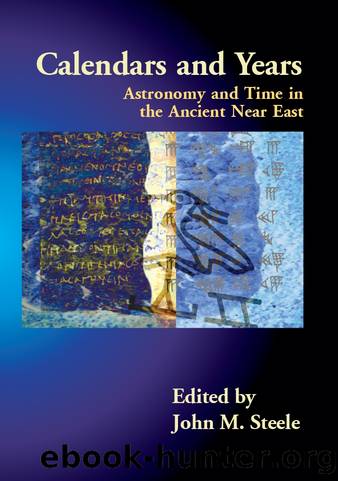Calendars and Years by John M. Steele;

Author:John M. Steele;
Language: eng
Format: epub
ISBN: 9781782974932
Publisher: Casemate Publishers & Book Distributors, LLC
Published: 2013-08-27T00:00:00+00:00
The 360-Day Year in Mesopotamia
Lis Brack-Bernsen
The Cultic or Civil Calendar and the âAdministrative Calendarâ
From ancient Mesopotamia we know two different âcalendarsâ: the cultic or civil calendar and the âadministrative calendarâ.1 In both calendars, the year was the largest unit. In the cultic calendar, the year was divided into lunar months of 29 or 30 days. In the administrative calendar each month was put equal to 30 days. As we shall see, the administrative calendar was only used in the context of making calculations and never for dating. This latter use was taken care of by the cultic calendar which was defined by the solar year and by lunar phases: the first day of a new month began on the evening when the new crescent became visible for the first time after conjunction. First visibility takes place either 29 or 30 days after the previous first visibility. Since the sequence of 29- and 30-day months is highly irregular the cultic calendar was troublesome to handle. The mean value of the synodic month (the time between two consecutive conjunctions or oppositions) is approximately 29.53 days, so that 12 lunar months equals about 354.37 days, some 10.88 days shorter than the solar year. Therefore, on the average, an intercalated month was necessary every three years or so in order to keep the months in tune with the seasons.
This paper shall present textual evidence for the claim that both systems of time measurements were used simultaneously from the early dynastic time (ca. 2600 BC) until around 1000 BC when the astronomical-astrological compendium MUL.APIN was composed. Prior to the early dynastic period there is insufficient evidence to say for certain whether the lunar calendar was used; the protoliterate texts (from ca. 3200 BC) have not been understood sufficientlyâone can only speculate, that some signs in Uruk III texts may refer to the kind of cultic lunar month known from later periods. However, the number systems in these very early texts are sufficiently well understood to enable us to understand the calculations they contain and to establish that rations in bureaucratic texts were calculated of the basis of the administrative year. The paper shall also clarify how (i.e., for what or in which way) the two calendars were used: the cultic calendar for dating and the administrative one for centralized bookkeeping and later also for astronomy. For example, in MUL.APIN, a canonical astronomical /astrological text perhaps dating from around 1000 BC, we find astronomical schemes in which the ideal year of 360 days is used, together with indications of how to adjust schematic values according to observations.
I start with Ur III texts, which are understood profoundly, and then go backwards in time to the earlier texts. The knowledge gained from the Ur III texts makes it is easier to understand and explain older texts. For textual evidence from earliest times until the end of Ur III times (2000 BC), I rely mostly on R. K. Englundâs investigations in âAdministrative Timekeeping in Ancient Mesopotamiaâ (1988), a careful and systematic analysis of all available texts of interest together with many useful references.
Download
This site does not store any files on its server. We only index and link to content provided by other sites. Please contact the content providers to delete copyright contents if any and email us, we'll remove relevant links or contents immediately.
| Africa | Americas |
| Arctic & Antarctica | Asia |
| Australia & Oceania | Europe |
| Middle East | Russia |
| United States | World |
| Ancient Civilizations | Military |
| Historical Study & Educational Resources |
The Daily Stoic by Holiday Ryan & Hanselman Stephen(3158)
The Fate of Rome: Climate, Disease, and the End of an Empire (The Princeton History of the Ancient World) by Kyle Harper(2932)
People of the Earth: An Introduction to World Prehistory by Dr. Brian Fagan & Nadia Durrani(2647)
Ancient Worlds by Michael Scott(2541)
Babylon's Ark by Lawrence Anthony(2465)
Foreign Devils on the Silk Road: The Search for the Lost Treasures of Central Asia by Peter Hopkirk(2396)
The Daily Stoic by Ryan Holiday & Stephen Hanselman(2391)
India's Ancient Past by R.S. Sharma(2335)
MOSES THE EGYPTIAN by Jan Assmann(2313)
The Complete Dead Sea Scrolls in English (7th Edition) (Penguin Classics) by Geza Vermes(2175)
Lost Technologies of Ancient Egypt by Christopher Dunn(2148)
The Earth Chronicles Handbook by Zecharia Sitchin(2123)
24 Hours in Ancient Rome by Philip Matyszak(1997)
Alexander the Great by Philip Freeman(1987)
Aztec by Gary Jennings(1901)
The Nine Waves of Creation by Carl Johan Calleman(1812)
Curse Tablets and Binding Spells from the Ancient World by Gager John G.;(1792)
Before Atlantis by Frank Joseph(1761)
Earthmare: The Lost Book of Wars by Cergat(1737)
